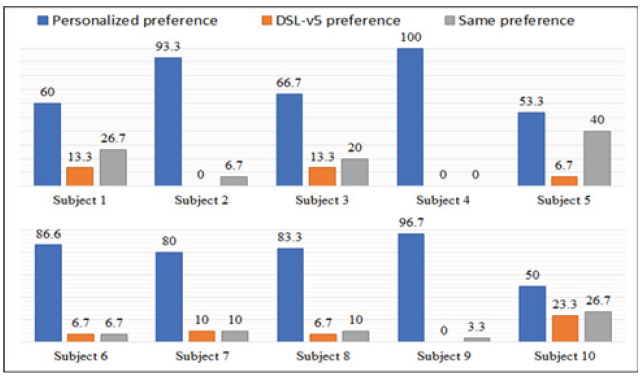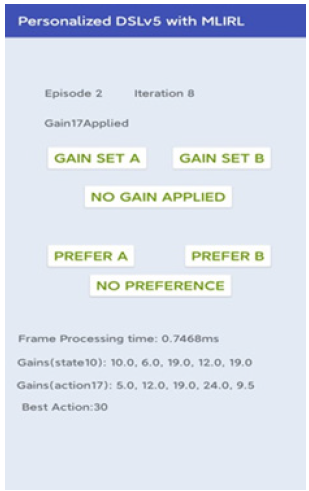Mini Review 
 Creative Commons, CC-BY
Creative Commons, CC-BY
Machine Learning Solutions for Systematic Personalization of Amplification in Hearing Aids
*Corresponding author:Nasser Kehtarnavaz, Department of Electrical and Computer Engineering, University of Texas at Dallas, Richardson, TX, USA.
Received:January 07, 2023; Published:January 18, 2023
DOI: 10.34297/AJBSR.2023.17.002406
Abstract
One major limitation of the current standard of hearing aid fitting is that there is little provision for individual user amplification preferences and hearing aids are normally programmed based on standard prescriptions. These prescriptive targets are based on the average needs of users with similar levels of hearing loss with no standard provision for individual input. In this mini review article, an overview of machine learning solutions that have recently been developed to systematically incorporate hearing aid users’ individual preferences into a prescription is presented. It is envisioned that such machine learning solutions would have a significant impact on the way future generations of hearing aids would be programmed by audiologists to better address the individual needs of hearing aid users.
Personalization of Amplification in Hearing Aids via Machine Learning
The conventional hearing aid fitting process primarily consists of obtaining a person’s pure tone thresholds or audiogram and applying a prescriptive fitting rationale based on the audiogram. The two most widely used hearing aid fitting rationales are DSLv5 [1] and NAL-NL2 [2], which are derived from average values of hearing-impaired individuals with similar levels of hearing loss. Essentially, the fitting process involves applying appropriate gain values depending on the input level of sound signals across several frequency bands. Often, 5 to as many as 20 frequency bands are used. This process does not take into consideration the personalization aspect despite the evidence that different individuals with similar hearing loss encounter different audio environments and that their hearing preferences in those environments may not be the same. Previous studies, e.g. [3,4], have shown that nearly half of hearing aid users prefer different amplification gains than those provided by standard prescriptive fitting rationales. Hearing aid adjustments to accommodate for variations in preferences are typically performed manually in an ad hoc manner by clinicians and not in a systematic manner, e.g. [5,6]. Moreover, no universally accepted protocols exist for making these types of individual adjustments. Although hearing aid companies have attempted to incorporate user preferences into hearing aids post-fitting, e.g. [7], these approaches are proprietary, not informed by clinician oversight and have not been open to rigorous evaluation for efficacy.
To enable achieving personalization of hearing aid fitting in a systematic manner towards improving hearing, particularly for noisy environments, there has been an increasing use of machine learning technology in recent years. Using a machine learning solution developed by our research team [8,9], personalization of amplification for hearing aids was achieved by examining pairs of speech stimuli amplified by two different sets of gain values across five frequency bands in competing speech babble noise. The participants in this study were asked to pick the preferred stimulus from a pair of audio signals. A deep neural network was trained based on a participant’s preference feedbacks to reach the machine learning derived individualized gain values. When these personalized gain values were compared to the standard prescriptive gain values of DSLv5, participants preferred the personalized settings about seven times more than those of the standard DSLv5 settings.
Whereas the machine learning-based personalization in [8,9] provided promising results, the offline training of its deep neural network poses a significant limitation for deployment in real-world audio environments because its training is required to be done in an offline manner rather than in an on-the-fly or online manner which is what is needed for field deployment. This offline training limitation has been overcome and reported by our research team in [10] using the machine learning method of Maximum Likelihood Inverse Reinforcement Learning (MLIRL). This personalization of amplification identifies the most preferred combination of gain values across five frequency bands (easily extendable to any number of frequency bands) for a specific user. Like [8,9], paired comparisons of audio signals were performed by ten participants in the study reported in [10]. Paired comparisons provide an easy way for hearing aid users to state their preference feedbacks to reach an optimum personalized set of gain values. The participants were asked to indicate their preference between two audio signals, one amplified by the standard prescription DSLv5 gain values and the other by the personalized gain values for a total of 50 randomly selected audio signal pairs in the presence of multi-talker babble background noise at a 5dB signal-to-noise ratio. The outcome of the study is shown in Figure 1.

Figure 1:Outcome of preference experiments in percentages between personalized and standard DSLv5 amplification [10].
The results indicate that the personalized settings were clearly preferred by the participants over the standard settings across different audio signals heard. In other words, the number of times the personalized gain values were preferred by the participants was on average about 10 times higher than the number of times the standard gain values were preferred. It is worth noting here that although it is possible to reach the same optimum settings by carrying out paired comparisons in an exhaustive manner, such an approach is very time consuming and not practical due to the fatigue and tiredness that occurs in human users. The developed machine learning method allows reaching the most preferred set of gain values in a systematic manner within a much shorter time duration (e.g., less than one hour compared to many hours) when done in an online manner in real-world audio environments.
The online training of the developed machine learning-based method can be achieved using a smartphone app. Such an app has been recently developed by our research team, which is briefly noted here (Figure 2).
Figure 2 illustrates the GUI (graphical user interface) of the app online training session. Once a training session is launched, the user hears the audio sound of the environment captured by the smartphone microphone without any gain values applied. The listening can be done through a wired headset, a Bluetooth headset, or Bluetooth-enabled hearing aids with its amplification or compression set to flat or no gain. By tapping the button “Gain Set A” or “Gain Set B”, a set of gain values derived by the machine learning method are applied across five frequency bands based on the audiogram of the user previously inputted into the app. Then, the user indicates his or her hearing preference between these two gain settings (pair comparison) by clicking one of these buttons: “Prefer A”, “Prefer B”, or “No Preference”. At the end of the training session, the final personalized gain values are stored which can then be compared to the prescriptive gain values.
Conclusion
The current standard of care for hearing aid users implements an average-based prescriptive amplification strategy that does not incorporate individual preferences in a systematic way. The studies reported in this mini review article indicate that a systematic deployable mechanism to individualize a prescriptive amplification for heading aids can be achieved in real-world audio environments by using machine learning solutions that are being developed by our research team. It is expected that such machine learning solutions will lead to more effective hearing aid fitting and improve outcomes for hearing-impaired users.
References
- M Bagatto, S Moodie, S Scollie, R Seewald, K Moodie, et al. (2005) Clinical protocols for hearing instrument fitting in the Desired Sensation Level method. Trends Amplif 9(4): 199-226.
- G Keidser, H Dillon, M Flax, T Ching, S Brewer, et al. (2011) The NAL-NL2 prescription procedure. Audiol Res 1(1): e24.
- G Keidser, AO Brien, L Carter, M McLelland, I Yeend, et al. (2008) Variation in preferred gain with experience for hearing-aid users. Int J Audiol 47(10): 621-635.
- G Aldaz, S Puria, L Leifer (2016) Smartphone-Based System for Learning and Inferring Hearing Aid Settings. J Am Acad Audiol 27(9): 732-749.
- J Chalupper, D Junius, T Powers (2009) Algorithm lets users train aid to optimize compression, frequency shape, and gain. The Hearing Journal 62(8): 26,28,30-33.
- N Alamdari, E Lobarinas, N Kehtarnavaz (2019) An Educational tool for Hearing Aid Compression Fitting via a Web-based Adjusted Smartphone App. ICASSP pp: 7650-7654.
- Widex (2019) Machine learning makes this hearing aid smart.
- N Alamdari, E Lobarinas, N Kehtarnavaz (2020) Personalization of Hearing Aid Compression by Human-in-the-Loop Deep Reinforcement Learning. IEEE Access 8: 203503-203515.
- S Akbarzadeh, N Alamdari, C Campbell, E Lobarinas, N Kehtarnavaz (2020) Word Recognition Clinical Testing of Personalized Deep Reinforcement Learning Compression. Proceedings of IEEE 14th
- S Akbarzadeh, E Lobarinas, N Kehtarnavaz (2022) Online personalization of compression in hearing aids via maximum likelihood inverse reinforcement learning. IEEE Access 10: 58537-58546.




 We use cookies to ensure you get the best experience on our website.
We use cookies to ensure you get the best experience on our website.